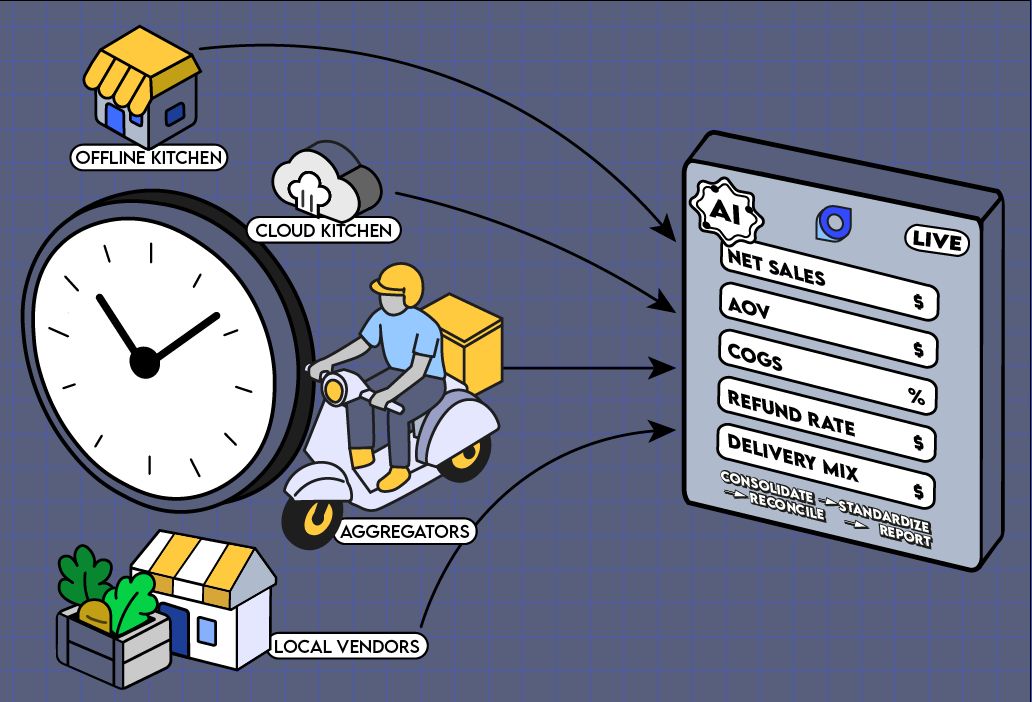Finance teams today navigate a complex world of business data, and their approach combines traditional methods with increasingly sophisticated tools. Here's a breakdown of how they handle this data:
Traditional Methods
1. Spreadsheets: Still a workhorse for many teams, spreadsheets are used for data entry, basic calculations, and building reports. However, they can be error-prone and cumbersome for large datasets.
2. Manual Data Collection and Processing: Finance teams might still collect data manually from various sources, a time-consuming and inefficient process.
3. Limited Data Analysis: Financial analysis might be restricted to basic calculations and trend identification without advanced tools.
Modern Techniques with Technology
1. Enterprise Resource Planning (ERP) Systems: Many businesses use ERPs to centralize financial data from various departments, improving accessibility and consistency.
2. Cloud-Based Accounting Software: Online accounting software allows for real-time data access, collaboration, and automated tasks, streamlining financial processes.
3. Financial Business Intelligence (BI) Tools like Bluecopa: These advanced tools integrate data from multiple sources, automate tasks, provide advanced analytics, and offer data visualization for deeper insights.
4. Data Warehousing: Data warehouses store large volumes of historical financial data, enabling trend analysis and forecasting.
What’s the ideal approach?
The ideal approach involves a combination of these methods. Finance teams can leverage traditional spreadsheets for specific tasks while relying on cloud-based accounting software and ERP systems for core financial data management. Financial BI tools become crucial for analyzing big data, generating reports and insights, and making data-driven financial decisions.
So, what is financial business intelligence?
Financial business intelligence (BI) is essentially a way to analyze an organization's financial health by gathering, processing, and visualizing financial data. This data can come from various sources like accounting systems, transaction records, and even market data.
The goal is to use this analysis to make better business decisions. Financial BI helps track important financial metrics like sales, expenses, and profitability. It can also be used to monitor market trends and identify areas for improvement.
What are the benefits of financial BI?
Below are some advantages of financial BI—
🚀 Real-time insights: Financial BI can provide immediate access to financial data, allowing for quicker and more informed decision-making.
🚀 Improved reporting: Financial BI automates report generation, freeing up time for analysis and interpretation.
🚀 Cost savings and revenue growth: By identifying areas for improvement in financial performance, businesses can save costs and find new revenue streams.
🚀 Increased efficiency: Financial BI streamlines financial processes and reduces manual work.
🚀 Transparency and collaboration: Financial BI can improve communication and collaboration between finance and other departments.
What are some roadblocks when implementing financial business intelligence?
Even though financial BI offers significant advantages, implementing it can come with its own set of challenges. Here are some common roadblocks you might encounter:
#1 Data Quality and Consistency
Financial data can be scattered across different systems and formats, leading to inconsistencies and inaccuracies. Cleaning and standardizing this data is crucial for reliable analysis.
🛠️ How to fix it?
Data Integration Tools: Invest in data integration tools that can automatically extract, transform, and load (ETL) data from various sources into a central, standardized format.
Data Governance: Implement data governance policies to ensure data quality standards are defined, monitored, and enforced.
Data Validation Rules: Set up data validation rules within the BI system to catch inconsistencies during data entry.
#2 Data Security
Financial data is sensitive, so ensuring robust security measures are in place to protect it during collection, storage, and access is vital.
🛠️ How to fix it?
Access Controls: Implement role-based access controls to restrict access to sensitive financial data.
Data Encryption: Encrypt financial data at rest and in transit to prevent unauthorized access.
Regular Security Audits: Conduct regular security audits to identify and address potential vulnerabilities.
#3 Resistance to Change
People accustomed to traditional financial reporting methods might be hesitant to adopt new BI tools and processes.
🛠️ How to fix it?
Communication and User Adoption Strategies: Communicate the benefits of financial BI and involve key stakeholders in the implementation process.
Provide User-Friendly Tools: Opt for BI tools with intuitive interfaces and user-friendly features to encourage adoption.
Showcase Success Stories: Highlight positive outcomes and success stories achieved using financial BI to demonstrate its value.
#4 Cost
Financial BI software and infrastructure can be expensive, and ongoing maintenance can add to the cost.
🛠️ How to fix it?
Cost-Benefit Analysis: Conduct a thorough cost-benefit analysis to evaluate the potential return on investment (ROI) before implementing financial BI.
Open-Source or Cloud-Based Solutions: Consider cost-effective alternatives like open-source BI tools or cloud-based solutions with pay-as-you-go options.
Phased Implementation: Implement BI in phases, starting with core functionalities, to manage upfront costs.
Why do finance teams can't handle big data without financial BI tools?
Traditional financial processes and tools often struggle to handle the vast amount of data generated in today's business environment. Here's why finance teams specifically might face challenges with big data without financial BI tools:
Data Silos and Incompatibility
Financial data often resides in disparate systems like accounting software, general ledgers, and ERP systems, making it difficult to consolidate and analyze together. Financial BI tools can integrate data from various sources into a central repository, enabling comprehensive analysis.
Limited Automation and Manual Work
Traditional methods often involve manual data extraction, cleansing, and manipulation, which can be time-consuming, error-prone, and inefficient for big data volumes. Financial BI automates these tasks, freeing up finance teams for higher-level analysis.
Slow Reporting and Insights
Manually generating reports from siloed data is slow and cumbersome. Financial BI tools provide real-time access to data and facilitate the creation of dynamic reports and dashboards, enabling faster and more data-driven decision-making.
Difficulty with Complex Analysis
Big data often requires advanced analytical techniques that traditional tools might not support. Financial BI tools offer features like data mining and predictive analytics, allowing finance teams to uncover deeper insights from complex datasets.
Limited Data Visualization
Traditional spreadsheets might not be ideal for presenting complex financial data effectively. Financial BI tools provide sophisticated data visualization capabilities to communicate insights clearly to both financial and non-financial audiences.
How to build financial business intelligence with Bluecopa?
Here's a roadmap for building financial business intelligence (BI) with Bluecopa—
1. Define Your Goals and Needs
- Identify Key Performance Indicators (KPIs): What financial metrics are most important to track for your organization? (e.g., revenue, profitability, cash flow)
- Reporting Requirements: What kind of financial reports do you need to generate regularly? (e.g., income statements, balance sheets, variance analysis reports)
- User Needs: Who will be using the BI platform? (e.g., finance team, executives, other departments) Understanding their needs will help determine the specific functionalities required.
2. Data Source Identification and Integration
List all relevant data sources: This includes accounting software, ERP systems, CRM systems, and any other platforms where your financial data resides.
Data Integration Strategy: Determine how BlueCopa will connect to these data sources. BlueCopa might offer pre-built connectors for popular financial systems or a custom integration approach might be needed.
3. Data Cleaning and Transformation
Data Quality Assessment: Evaluate the quality of data in your source systems. BlueCopa might have data cleansing tools to address inconsistencies or errors.
Data Transformation: Transform raw data into a format suitable for analysis within BlueCopa. This might involve creating calculated fields or hierarchies within the platform.
4. Building Financial Reports and Dashboards
BlueCopa's Features: Leverage BlueCopa's specific features to design reports and dashboards. This might involve pre-built financial templates and custom visualizations.
Tailored Reports and Dashboards: Create reports and dashboards specific to your KPIs and user needs. Ensure they are clear, concise, and visually appealing for effective communication.
To get started with modern financial business intelligence, contact us today.
Finance business intelligence FAQs.
1. What role does business intelligence play in finance?
Business intelligence (BI) plays a critical role in finance by transforming raw data into actionable insights that empower data-driven decision-making. Here's a breakdown of its key functions:
#1 Improved Financial Reporting and Analysis
#2 Enhanced Financial Performance Management
#3 Increased Efficiency and Transparency
2. Why is financial business intelligence required?
Financial business intelligence (BI) is crucial for three reasons:
Reason #1: Drowning in Data, looking for Insights!
Businesses generate massive amounts of financial data. Traditional methods struggle to handle this volume effectively. BI tools consolidate data from various sources, allowing for comprehensive analysis and uncovering hidden patterns within the data.
Reason #2 Intuition vs. Data-Driven Decisions
Financial decisions based solely on gut feeling can be risky. BI provides data-driven insights to support informed choices. Imagine comparing historical sales data with marketing campaign data to predict future sales performance – a far cry from simply hoping for a good outcome.
Reason #3 Beyond Basic Reporting
Spreadsheets can't handle the complexity of big data. BI offers advanced features like data mining and predictive analytics, enabling finance teams to uncover trends and anticipate future financial performance.




